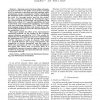Free Online Productivity Tools
i2Speak
i2Symbol
i2OCR
iTex2Img
iWeb2Print
iWeb2Shot
i2Type
iPdf2Split
iPdf2Merge
i2Bopomofo
i2Arabic
i2Style
i2Image
i2PDF
iLatex2Rtf
Sci2ools
CIC
2006
2006
The Impact of Clustering in Distributed Topology Control
Abstract-- Topology control is the problem of assigning power levels to the nodes of an ad hoc network so as to maintain a specified network topology while minimizing energy consumption (either minimizing the maximum power used by any node or minimizing the total (i.e. average) power used by the nodes). In [18], a hybrid framework for distributed topology control based on clustering was proposed. That framework, called CLTC, specifies algorithms for both 1-connected and 2-connected topologies, and works with any clustering algorithm. CLTC utilizes centralized topology control within each cluster, but is otherwise fully distributed, hence the characterization of the method as hybrid. This paper studies the effect of six representative clustering methods on the quality of the topology control solutions provided by CLTC. The results establish that the most important factors in determining the performance of CLTC are the average cluster size and the closeness of nodes in clusters. This lea...
| Added | 30 Oct 2010 |
| Updated | 30 Oct 2010 |
| Type | Conference |
| Year | 2006 |
| Where | CIC |
| Authors | Liang Zhao, Errol L. Lloyd |
Comments (0)

